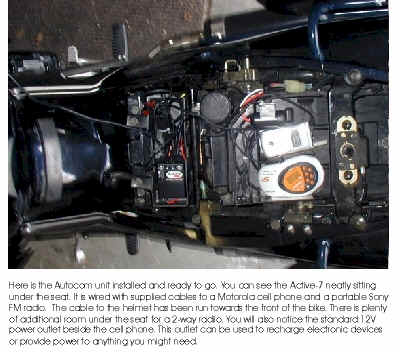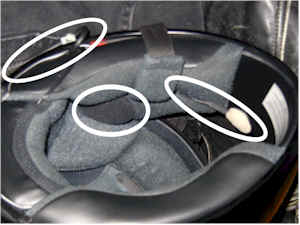|
|
|
Autocom Active-7-Smart Motorcycle Communications System Test
|
 |
The Active 7 unit does not have internal battery power creating the need to wire these units to the bikes. With 3 bikes and two Active 7 units, it would be nice to be able to use these units between bikes. On the way home I stopped by a local Radio Shack to pick up some "M" Coaxial power connectors to make some quick power disconnects. This is a standard size power connector of the type seen on most electronic equipment today. These $3 connectors would allow the quick movement of the units between bikes. As an additional benefit, I'd be able to use the Autocom units in automobiles at SCCA Solo II and drag racing events though a 12V power outlet adapter (a cigarette lighter plug in the cars).
 |
It took little time to install the two included speakers and boom microphone in my Shoei helmet. Placement instructions from Autocom were easy to follow and allowed me to place the speakers/mike correctly the first time. I tested everything by putting a set of alligator clips to the power wires from the Autocom unit and connected them to a spare 12V battery I had. I left the Volume and VOX settings in the original settings. As soon as the helmet was connected to the Autocom with a very robust and easy to line up connector, I was able to hear myself speaking. At least I knew the unit was working. I connected in my cell phone and had my wife call me. With the phone set on auto answer, it picked up immediately and I had a crystal clear conversation with her. Our static testing was a success.
Let the testing begin
I wired the coax power connector into the tail light circuit of my ZZR-1200 to
make sure voltage was only available when the ignition switch was on. I placed
the Autocom unit and cell phone under under the seat, connected power and ran
the cable to the helmet connector out the front of the seat, then took a ride.
Again I had my wife call my cell phone at speeds up to 80MPH. In each case, the
communications was crystal clear at both ends.
It was time for the acid test. Making sure that the units would work on a noisy Harley. After installing the speakers/microphone in a Simpson helmet and wiring the second unit up on my wife's FXD under the seat, we took a little ride. Because we were still testing with cell phones, a phone call was initiated from one cell phone to the other. The second phone picked up immediately and we were talking with no problem. No static, no wind noise and no loud potato-potato throb coming through in the sound. Absolutely amazing. Of course this was sitting still. I quickly realized that the VOX setting on the HD was a little low because the mike could be triggered by rapping the throttle. A quick change to the VOX setting and the problem was solved. A 45 minute ride at legal speeds yielded perfect communications between the two bikes. Not one single missed word. Static communication testing on our second Harley was just as successful as on the other two bikes.
The Good
At this point I must admit that I'm actually getting quite impressed with the
capabilities of the Autocom unit. The results of testing with cell phone to cell
phone communications between bikes was a complete success. I decided to test the
music capabilities of the unit. I connected a music source to the Autocom and
went for a ride. The quality of the sound was amazingly good considering I was
listening over engine and road noise. While not quite the same as listening to
my stereo in my living room, the music was crisp and clear, making for a
enjoyable ride. I even received a call and was able to carry a normal
conversation to the person at the other end. It was not evident to the calling
party that you are on a motorcycle.
The Bad
All testing to this point was done under conservative, legal riding conditions.
While many riders are responsible cyclists most of the time, a recognizable
percentage of us do like to twist the throttle a little harder from time to
time. I've got a second Harley that has a more aggressive exhaust note. This
would be the true test on how well Autocom systems work under hard riding. I
went for a very spirited ride on this bike after moving one of the units to this
bike. While mostly legal cruising speeds did not effect the system, it was
almost immediately obvious that the Autocom VOX unit was having trouble with the
sound level of this bike under heavy acceleration. The VOX would key the mike
anytime the accelerator was twisted more than 50-60%. Adjusting the VOX setting
to the 180MPH level did not eliminate this issue.
The poor performance of the Autocom unit on the Harley under full throttle shook my faith in the ability of the Active 7 to handle “any bike, any speed”. More full throttle testing was required on my sport bike. Since I had placed the coax power connectors on each bike, moving the unit from the HD to the ZZR1200 took less than 5 minutes. Out on the road with the ZZR I tried some full throttle acceleration runs in the lower gears. The engine and exhaust noise associated with accelerating to triple digit speed did not cause the VOX to key the mike. There was no attempt at making top speed runs to test the limits of the units.
The Ugly
To be fair to Autocom, I e-mailed the USA and Corporate technical support sites
describing what I had found and noted that there was going to be a published
review of the Active-7 unit. In both cases I got a response asking me to verify
the VOX settings I had used on the motorcycle. I sent my answers back to them on
the same day explaining that I had properly adjusted the VOX, asking for
additional guidance on resolving this issue. I am working with Autocom to work
through the issues on this one motorcycle.
Testing Summary
| Test Number |
From | To | Riding Style | Notes | Results |
| 1 | Sport Bike | Home Phone | Static | No Problems | OK |
| 2 | Sport Bike | Home Phone | Normal Riding | Adjusted VOX | OK |
| 3 | Sport Bike | Harley | Normal Riding | Adjusted Volume | OK |
| 4 | Harley | Home Phone | Very Spirited | VOX keys mike under heavy throttle | Only usable if PTT added |
| 5 | Sport Bike | Home Phone | Very Spirited | Sometimes wind noise would key mike | OK |
What is left to test?
As of this writing, I have not tested the Autocom unit with a set of two way
radios. I am waiting for a wiring adapter to connect the unit to some GMRS
radios. There is little reason to expect any new issues with the Active 7.
The Bottom Line
Autocom makes a very good motorcycle communication device that works well under
a wide variety of circumstances. From the least expensive Easy Rider, to the
middle priced Active 7, or the top of the line Pro Rider, you can purchase the
communication capabilities you need. The flexibility of these units goes way
beyond bike-to-bike communications, rider-to-passenger intercom and music input.
Because you have your choice of radios, you could use CB, FRS, GMRS, VHF or UHF
radios. You can also use your cell phone or walkie-talkie style cell phone. Then
you can add music in the form of a radio, CD or MP3. You can also wire in your
radar detector and GPS. While I didn't get a chance to test all of these
capabilities, they should work within the established limits.
Any Bike, Any Speed?
I can state with authority that the "Any Bike" may be inaccurate. A v-twin engine with an aftermarket exhaust will easily outstrip the
VOX capability of the Autocom unit while the bike is accelerating hard. There is
a high probability that this statement applies to all v-twins; cruiser and sport
bike. But there is little doubt in my mind that you could go well beyond any
legal USA speed limit and be able to carry on a normal conversation with someone
on another bike or talk with someone on their cell phone. An extensive review of
Internet postings and bulletin board discussion about Autocom seems to put the
practical maximum useful speed limit of the unit at 120MPH.
Summary
You should consider Autocom if you are looking for communications quality,
reliability and flexibility for your motorcycle. You will be hard pressed to
find a better capabilities at the cost of the Autocom units. However it is
important that you understand there are limits to its capabilities and technical
support from Autocom may be limited.
For more information see:
Autocom Main Web site
Autocom USA Distributor
| Copyright 1997-2006 Stephen Mullen, Oldsmar, FL -+- |